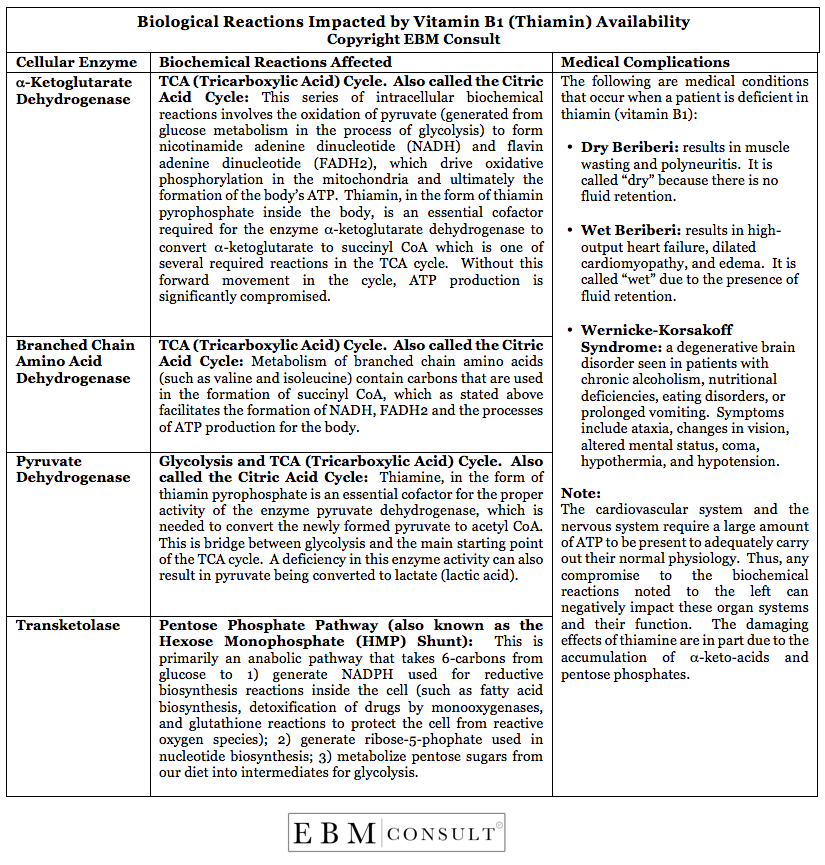Vitamin
B1 (thiamine) is a well known water-soluble vitamin required by the human body
to carry normal biologic reactions.1 Our bodies get thiamine from two
different sources with the majority coming from our diet and the remaining from
normal flora found in our large intestines. The problem with thiamine is
our ability to become deficient fairly quickly compared to other
vitamins. This is in part why thiamine is added to some foods and reported
on many food labels. Natural sources of thiamine include whole-grain
cereals and breads, legumes, and meats, such as pork and liver, whereas milk,
fruits, seafood and vegetables are not good sources.1 The reason we are at
risk of becoming deficient in thiamine quicker than some other vitamins has to
do with the way our bodies handle thiamine once it is absorbed.
Upon
absorption into the body, thiamine is used to form thiamine pyrophosphate, which
as noted in the table provided is an essential co-factor used by several
cellular enzymes.2 The pyrophosphate portion is important since this
group on the thiamine is used to bind to magnesium and then further bind to
amino acid side chains on the cellular enzyme.2 This allows the thiamine
pyrophosphate to function as a co-factor to that enzyme so that it can
facilitate the forward movement of its assigned biochemical reaction.
Unfortunately, thiamine pyrophosphate binding to the enzyme is relatively weak
and thus results in a high turn over of thiamine by the body.2 Therefore,
a patient who consumes a thiamine deficient diet or has impaired absorption of
thiamine from the intestines can easily become deficient.

As
summarized in the table provided, a deficiency in thiamine primarily impacts the
efficient and adequate production of high-energy compounds, more specifically
ATP, for the body to use.2 The organ systems with high metabolic rates or
demands are likely to be impacted the greatest by a reduction in available
ATP. Such organ systems include the cardiovascular system and the nervous
system. In fact, the most well known complications due to thiamine deficiency
are Dry Beriberi, Wet Beriberi and Wernicke-Korsakoff Syndrome.3,4 The
"wet" form of beriberi has to do with the presence of fluid
retention. The more common condition seen in clinical practice is the
development of Wernicke-Korsakoff Syndrome in alcoholic patients, where
patients are commonly administered intravenous thiamine prior to receiving
glucose based nutrition or fluids.
References:
- Institute of Medicine. Food and Nutrition Board. Dietary Reference
Intakes for Thiamin, Riboflavin, Niacin, Vitamin B6, Folate, Vitamin
B12, Pantothenic Acid, Biotin, and Choline. National Academy Press,
Washington, DC, 1998.
- Lieberman M, Marks AD. Chapter 20: Tricarboxylic acid. In: Mark's Basic Medical Biochemistry A Clinical Approach. 3rd Ed. Lieberman M, Marks AD eds. Wolters Kluwer/Lippincott Williams & Wilkins. Philadelphia, PA. 2009.
- Medline Plus. Beriberi. U.S. National Library of Medicine/National Institutes of Health. Accessed December 2010.
- National Institutes of Health. National Institute of
Neurological Disorders and Stroke. NINDS Wernicke-Korsakoff Syndrome
Information Page. Accessed last December 2014.


